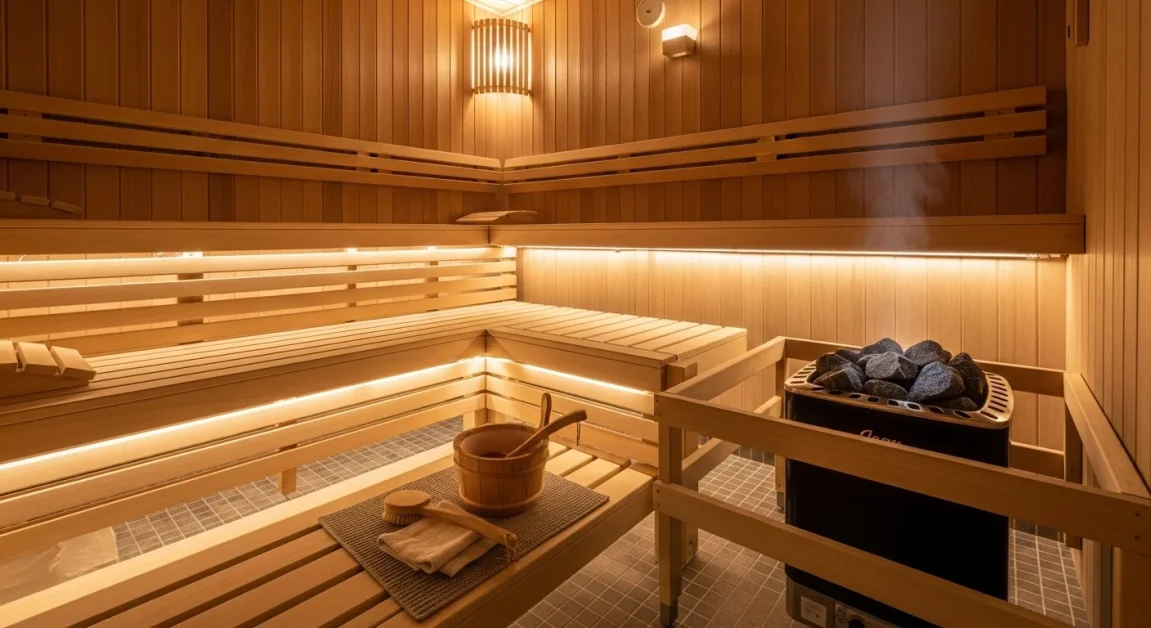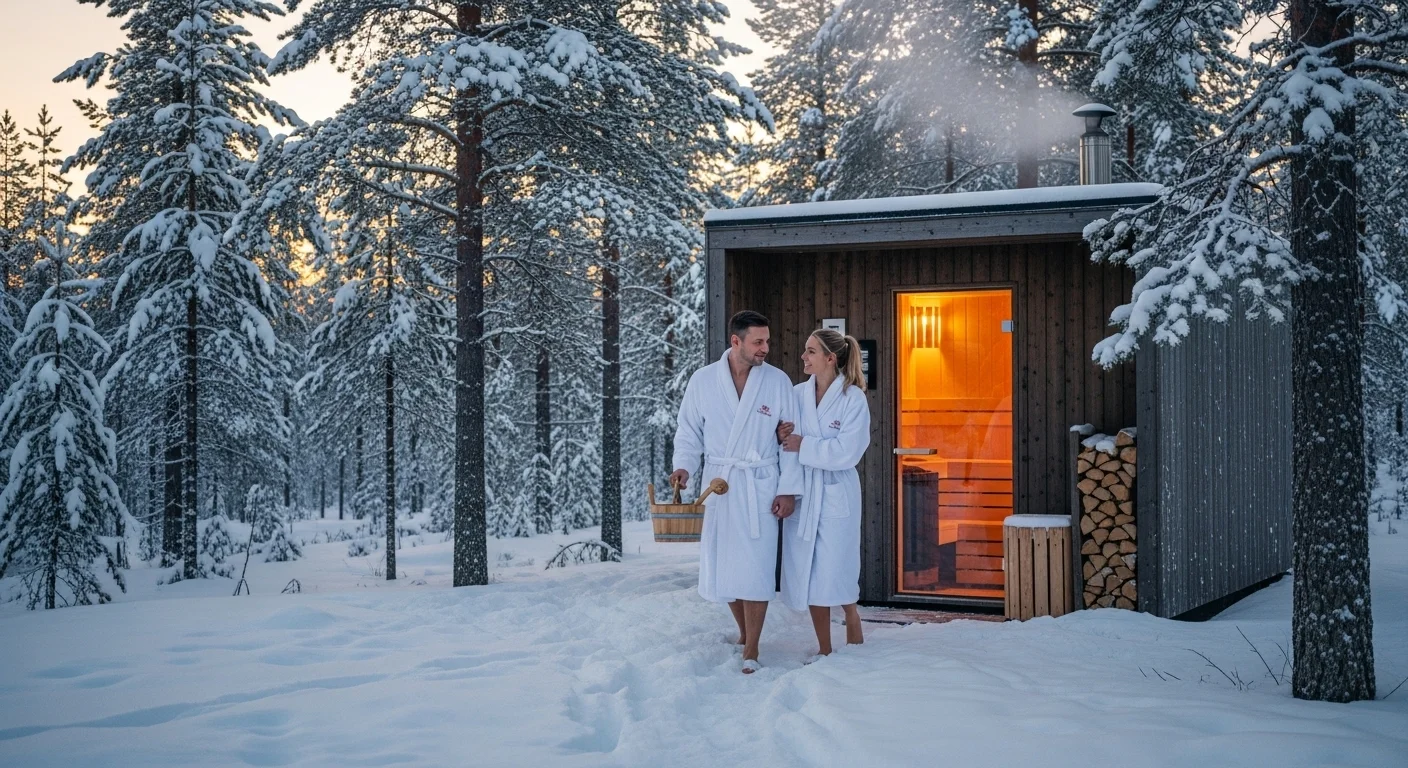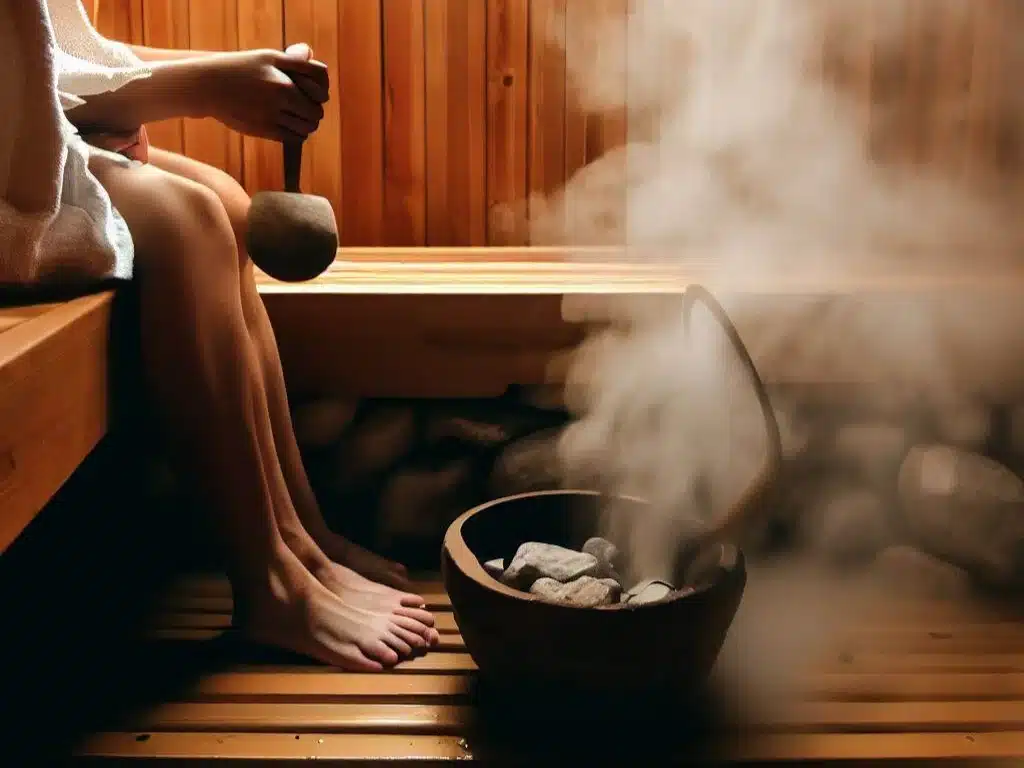Sauna Safety 101:
Sauna Safety 101 is about knowing how to enjoy the heat without risking your health. Stay hydrated, limit sessions to 15–20 minutes, and listen to your body.
Avoid alcohol, and step out if you feel dizzy or unwell. Whether it’s infrared or traditional, start slow and let your body adjust to the warmth.
- What is Sauna Safety 101 and Why It Matters
- Infrared Sauna Safety 101
- How to Sauna (Step-by-Step)
- How to Use Sauna at the Gym
- How to Use a Sauna with Rocks
- Sauna Benefits
- Sauna Safety Guidelines for Everyone
- Sauna vs. Steam Room: Which is Better for You
- Sauna Safety Rules
- 15 Rules and Regulations for Using a Sauna
- Why are Saunas Popular?
- Do and don'ts for sauna?
- FAQs

What is Sauna Safety 101 and Why It Matters
If you’ve never heard the term “sauna safety” before, it’s basically just knowing how to enjoy a sauna without feeling like you’ve signed up for a heat endurance contest. It’s about making sure the whole thing feels good during and after, instead of leaving you dizzy or wiped out.
Why does it matter? Well, a sauna can be amazing for relaxing your muscles, clearing your head, and just melting away stress.
But if you push it too far too hot, too long, or without enough water, you can go from spa day to “I need to lie down” pretty fast. I’ve seen people try to tough it out to impress their friends and end up regretting it.

A few common first-timer slip-ups:
- Staying in way longer than your body can handle
- Forgetting to drink water before and after
- Pouring too much water on the rocks and turning the place into a steam inferno
- Jumping in right after a heavy meal or a few drinks (bad combo)
Think of it like driving a car for the first time. You learn the rules, take it slow, and once you get the hang of it, the ride is way more enjoyable.
Infrared Sauna Safety 101
Infrared saunas are a bit different from the traditional ones you might find at a gym, where hot rocks or steam crank up the heat. Instead, these use invisible light waves to warm your body directly, not the air around you. It feels milder since the room isn’t blisteringly hot, but don’t be fooled, you’ll still be sweating buckets!

Here’s the thing: because it doesn’t feel as intense, some folks think they can hang out in there forever. Not a great idea. Your body’s core temperature is still climbing, so you’ve got to be just as careful as you would in a regular sauna. Here’s how to keep it safe and enjoy the experience.
How Long Should You Stay In?
For most people, infrared saunas run between 110–130°F. If you’re new to this, start with shorter sessions, think 15–20 minutes, and see how your body feels. Even if you’re a sauna pro, sticking to 30 minutes max is a smart move. Listen to your body: if you feel dizzy, too hot, or just weird, get out right away. No need to push it!
Hydrate, Hydrate, Hydrate
Drink some water before you hop in. It’s okay to sip a little during your session if you’re feeling parched. Afterward, chug some more to replace what you’ve sweated out. Staying hydrated keeps you feeling good and helps your body handle the heat.
Who Should Skip It?
Infrared saunas aren’t for everyone. If you’re pregnant, have heart issues, high blood pressure that’s not under control, or conditions like multiple sclerosis that make you sensitive to heat, check with your doctor first. Better safe than sorry!
Quick Tips for a Great Session
- Ease in slowly: Start with shorter sessions and lower temps if you’re new.
- Cool down after: Give your body time to adjust before jumping into a cold shower or heading out.
- Trust your instincts: Feeling off? Step out, cool off, and sip some water.
How to Sauna (Step-by-Step)
Getting the most out of a sauna isn’t complicated, but there’s a right way to do it so you feel amazing afterward instead of drained.

- Prepare your body – Drink water before you start. Eat something light if you’re hungry, but skip heavy meals.
- Pre-sauna hygiene – Take a quick shower to rinse off sweat, dirt, or lotions. This helps keep the sauna clean and lets your skin breathe better.
- What to wear – Most people go in with just a towel or lightweight swimsuit. The key is comfort and allowing your skin to sweat freely.
- Adjust the heat and humidity – If it’s a traditional sauna, add a little water to the rocks for steam. Go slow so you don’t make it too intense.
- Cool down – Step out, let your body cool naturally, or rinse off with cool water. Always rehydrate afterward.
How to Use Sauna at the Gym
Using the gym sauna isn’t hard, but there’s a bit of unspoken etiquette that makes the experience better for everyone.
- Know the rules – Most gyms post them right outside the door. Things like no shoes, no phones, and using a towel on the bench are pretty standard.
- Pick your timing – If you want peace and quiet, go during off-peak hours. Right after the evening rush can feel like rush hour in there.
- Share the space – Don’t spread your stuff everywhere or hog a corner. Give others room and keep the conversation at a low volume.
- Clean up – Take your towel, toss any trash, and give the bench a quick wipe if your gym provides spray or wipes. Leave it ready for the next person.
How to Use a Sauna with Rocks

Sauna rocks aren’t just for looks. They hold heat and release it slowly, creating that deep, even warmth. When you pour water over them, a tradition called löyly, you get a burst of steam that raises the humidity and makes the heat feel more intense.
To do it safely, stand back a bit and pour a small ladle of water at a time. Too much at once can send up a scorching cloud of steam and make it hard to breathe. Never use anything but clean water, and avoid oils or additives unless your sauna is designed for them.
Watch out for burns by keeping your hands, arms, and face away from the immediate steam blast. And for the rocks themselves, give them a quick check every few months. Replace any that are cracked, crumbling, or blocking air circulation so your sauna heats evenly and stays safe to use.
Sauna Benefits
- Better circulation and muscle recovery – Heat widens blood vessels, boosts blood flow, and helps muscles relax, easing soreness after workouts.
- Stress relief and better sleep – The warm, quiet environment helps you unwind and can improve sleep quality.
- Immune system support – A temporary rise in core temperature may help your body fight off certain illnesses.
- Athletic performance recovery – Increased blood flow can speed up healing and reduce fatigue between training sessions.

Sauna Tips for Beginners
- Start with shorter sessions – Begin with 10–15 minutes and work your way up as your body adjusts.
- Stay hydrated before and after – Drink water before entering and replenish fluids afterward.
- Listen to your body’s signals – If you feel dizzy, lightheaded, or unwell, step out right away.
- Avoid alcohol before sauna use – Alcohol can dehydrate you and raise the risk of overheating.
- Pair with cold therapy (optional) – A quick cool shower or plunge after can boost circulation and refresh you.
How to Start a Sauna at Home
- Choose the right type – Decide between infrared, electric, or wood-fired based on your budget, space, and heat preference.
- Plan for space and ventilation – Pick a spot with enough room to move comfortably and proper airflow to prevent moisture issues.
- Do safety checks before first use – Make sure wiring, heaters, and materials meet safety standards. Test everything before heating up.
- Keep up with maintenance – Wipe benches after each use, check rocks or panels regularly, and deep clean as needed to keep it safe and fresh.
New to home setups? Check out this sauna heater size calculator so you get the perfect heat every time.

Sauna Safety Guidelines for Everyone
- Know your limits – Most people do well with 10–20 minutes at 150–195°F for traditional saunas, or 15–30 minutes at 110–130°F for infrared.
- Special precautions – Children, elderly adults, and pregnant users should use lower heat and shorter times, and ideally get medical approval first.
- Check health conditions – Talk to a doctor if you have heart problems, uncontrolled high blood pressure, respiratory issues, or heat-sensitive conditions.
- Watch for warning signs – Leave immediately if you feel dizzy, nauseous, weak, or notice an irregular heartbeat. Safety comes before finishing the session.
Sauna vs. Steam Room: Which is Better for You
1. Heat type and humidity
- Sauna – Uses dry heat, often from heated rocks or infrared panels, with humidity levels around 5–20%.
- Steam room – Uses moist heat from a steam generator, keeping humidity near 100% with a lower air temperature.

2. Pros and cons
- Sauna pros – Higher heat tolerance for some people, helps with muscle recovery, may feel more comfortable for those sensitive to humidity.
- Sauna cons – Can feel too dry for people with respiratory issues.
- Steam room pros – Moist heat can help with congestion, skin hydration, and relaxation.
- Steam room cons – High humidity can feel overwhelming, especially for beginners or people with certain heart or lung conditions.
3. Which is safer for beginners
For most newcomers, a dry sauna is easier to handle because the lower humidity makes it feel less intense. But if you have breathing issues, a steam room’s moist air might feel better. Start slow in either option and see how your body responds.
Sauna Safety Rules
| Rule | Description |
|---|---|
| 1. Temperature | Maintain a safe sauna temperature, typically between 70-100°C (160-212°F). |
| 2. Ventilation | Ensure proper ventilation to allow fresh air circulation and prevent excessive humidity. |
| 3. Hydration | Stay hydrated by drinking water before, during, and after sauna sessions. |
| 4. Time Limit | Limit sauna sessions to 10-15 minutes and take breaks to prevent overheating. |
| 5. Clothing | Wear appropriate sauna clothing made of lightweight and breathable materials. |
| 6. Fire Safety | Avoid flammable materials in the sauna and be cautious with heating elements or candles. |
| 7. Alcohol | Avoid consuming alcohol before or during sauna sessions as it can increase the risk of dehydration and dizziness. |
| 8. Medical Conditions | Consult with a healthcare professional before using the sauna if you have any underlying medical conditions. |
| 9. Pregnancy | Pregnant women should consult with their doctor before using the sauna. |
| 10. Skin Protection | Protect your skin by sitting on a towel and avoiding contact with hot surfaces. |
| 11. Cleanliness | Maintain cleanliness by showering before entering the sauna and using a clean towel. |
| 12. No Food | Avoid eating heavy meals before using the sauna to prevent discomfort and digestive issues. |
| 13. Cool-Down | Allow your body to cool down gradually after a sauna session. |
| 14. Supervision | Children should always be supervised when using the sauna. |
| 15. Listen to Your Body | Pay attention to your body’s signals and exit the sauna if you feel unwell or uncomfortable. |
15 Rules and Regulations for Using a Sauna
Now, let us discuss some important rules and regulations you must follow when using a sauna. These rules are like a superhero’s cape that will keep you safe while you enjoy your sauna adventure!
Rule 1: Always Have an Adult with You
Just like crossing the road or going to a new place, having an adult with you is crucial when you want to use a sauna. An adult can help you understand the rules better and ensure safety. So always bring along a responsible grown-up when you want to have a sauna adventure!
Rule 2: Never Touch the Hot Rocks
The rocks inside a sauna can get extremely hot, like a dragon’s breath! So, it is super important to never touch them with your bare hands or any other body part. Ouch! Instead, you can sit on a towel to be safe and comfortable.
Rule 3: Don’t Stay Inside for Too Long
As much as you might enjoy the heat in the sauna, it is essential to remember not to stay inside for too long. Your body needs a break from the heat, like when you take a break from playing in the sun. So, listen to your body and take breaks to cool down.
Rule 4: Don’t Pour Water Directly on the Rocks
Adding water to the hot rocks in the sauna creates steam, which makes the room even hotter. But remember, only grown-ups should add water to the rocks, and they should do it carefully, without pouring it directly on the rocks. It is like watering a plant – you sprinkle the water gently so it does not get too hot.
Rule 5: Use a Towel to Sit or Lie On
Always use a towel to sit or lie on to keep the sauna clean and safe. Sitting directly on the wood or rocks can be uncomfortable and hot, so using a towel is like having a cozy cushion. Plus, it helps to keep the sauna clean for everyone to enjoy!
Rule 6: Keep Yourself Hydrated
When inside a sauna, your body sweats a lot, and you might feel thirsty. Drinking water before and after using the sauna is essential to keep yourself hydrated. Like how you drink water after playing outside, it is essential to drink water after being in the sauna to stay healthy and happy.
Rule 7: Don’t Use Electronics or Electrical Appliances
Saunas are not a place for electronics or electrical appliances. Water and heat do not mix well with electronics, and it can be dangerous to use them in a sauna. So, leave your gadgets outside the sauna and enjoy some screen-free time while you relax in the heat!
Rule 8: Don’t Use Oils or Lotions
As much as you might love the smell of your favorite lotion or oil, using them in a sauna is not safe. Oil and lotions can make the floor slippery, and it is like walking on a banana peel – you might slip and fall! So, save your lotions after the sauna, and enjoy the natural steamy goodness inside.
Rule 9: Be Mindful of Others
When you are inside a sauna, other people might be trying to relax and enjoy their time. It is essential to be mindful of others and respect their space. Keep your voice down and avoid loud noises or rough play. It is like being in a library – we use our indoor voices and be respectful to others.
Rule 10: Don’t Run or Play Inside the Sauna
Even though saunas can be fun, running or playing inside is not safe. The floor can be hot and slippery, and you might accidentally bump into something or fall. So, walk carefully and enjoy the calm and relaxing atmosphere of the sauna without any rough play.
Rule 11: Be Cautious When Exiting the Sauna
When it is time to leave the sauna, be cautious and take your time, your body might feel a little wobbly after being in the heat, so hold on to the handrails if there are any, and step out carefully. Just like coming down the stairs, it is essential to avoid slips or falls.
Rule 12: Avoid Alcohol and Drugs
Grown-ups know that alcohol and drugs are not safe for kids, and they are also not safe to use in a sauna. Alcohol and drugs can dehydrate your body and affect your heat tolerance. So, it is best to avoid them altogether when using a sauna and prioritize your safety and well-being.
Rule 13: Clean Up After Yourself
Just like how we clean up our toys after playing, it is also essential to clean up after ourselves in the sauna. Make sure to pick up any towels, bottles, or other items you may have used and dispose of them properly. Keeping the sauna clean and tidy is essential for everyone’s enjoyment and safety.
Rule 14: Follow the Sauna Etiquette
Saunas often have specific rules and etiquette posted on the walls or shared by the sauna facility. It is essential to follow these rules, such as not talking loudly, not splashing water, and respecting time limits. Following the sauna, etiquette ensures a harmonious experience for everyone using the facility.
Rule 15: Listen to the Sauna Attendant or Grown-ups
If there is a sauna attendant or a grown-up with you in the sauna, listen to their instructions and follow their guidance. They are there to ensure your safety and well-being, so respecting their authority and following their rules is essential.
We understand the importance of safety, especially for individuals who are menstruating if you’re wondering how to safely go to a sauna while on your period, we’ve got you covered with our comprehensive guide on menstrual hygiene in saunas.
Type of sauna?
There are 6 types of saunas, including:
- Traditional Saunas:
- These are the most common types of saunas and use heated rocks to create a high-temperature environment, which helps to induce sweating and promote relaxation.
- Infrared Saunas:
- These use infrared heaters to emit radiant heat that penetrates the skin and warms the body directly, rather than just heating the air. Infrared saunas are becoming increasingly popular due to their therapeutic benefits.
- Steam Saunas:
- Also known as steam rooms, these use high humidity and moist heat to promote sweating and relaxation. They are often found in gyms or spas.
- Electric Saunas:
- These use electric heaters to create heat and are similar to traditional saunas in their function but are often smaller and more portable.
- Wood-burning Saunas:
- These use a wood stove to heat the sauna room and are a traditional type of sauna popular in Scandinavia and other parts of Europe.
- Outdoor Saunas:
- These are saunas located outside and can be traditional, infrared, or wood-burning. They are often used for relaxation and socializing in a natural setting.
If you are unsure which style to get, this guide on which sauna is right for me breaks down the options in simple terms.
Why are Saunas Popular?
Saunas are popular because they make you feel relaxed and refreshed. When you are inside a sauna, the heat makes your body sweat, and sweating is like your body’s way of cleaning itself. It helps eliminate toxins and makes your skin look fresh and glowing.
Saunas are also an excellent way to unwind after a workout or a busy day, and they can be an enjoyable experience for people of all ages!
Our guide on sauna usage after a vasectomy is here, providing detailed insights and helpful tips to make the most of your post-vasectomy sauna session.

Related Article Section
- Can I Use My Attic as a Sauna? Exploring the Feasibility: Discover the factors to consider when contemplating turning your attic into a sauna space, including ventilation, insulation, and safety considerations.
- Can Sauna Induce Period? Separating Fact from Fiction: Dive into the discussion surrounding the claim that saunas can induce menstruation. Explore the scientific evidence and separate fact from fiction.
- Can I Do Sauna While Breastfeeding? What You Should Know: Learn the considerations and precautions for breastfeeding mothers interested in incorporating sauna sessions into their routine.
- Sauna Sessions Help Shrink the Waistline: Discover how sauna sessions can support your weight loss goals by promoting calorie burning, detoxification, and improving metabolism.
Do and don’ts for sauna?
✅ Do’s
- Hydrate before and after – Drink water before you go in and rehydrate when you’re done.
- Start slow – If you’re new, begin with shorter sessions (10–15 minutes) and build up.
- Shower first – A quick rinse helps keep the sauna clean and opens your pores.
- Use a towel – Sit or lie on it to protect the bench and stay more comfortable.
- Cool down gradually – Step out, rest, and let your body temperature normalize before jumping back in or leaving.
Curious about the science? Here is a full list of sauna health benefits backed by research.
🚫 Don’ts
- Don’t drink alcohol – It increases dehydration risk and can cause dizziness or fainting.
- Don’t stay in too long – Even if you feel fine, overexposure can be dangerous.
- Don’t bring electronics – The heat and humidity can ruin them (and it’s just not relaxing).
- Don’t go in if you’re sick – High heat can stress your body more.
- Don’t ignore warning signs – If you feel lightheaded, nauseous, or weak, get out right away.
Visit For more reading about Healing in Style by Hot Tub Patio and more information about Saunas.
FAQs
Sources:
- National Sauna Society
- PUBLIC SAUNA RULES
- Sauna Health Benefits: Are saunas healthy or harmful? (Harvard Health Publishing)
- Visit the CDC website for authoritative information on public health, disease prevention, and health promotion. Access the latest guidelines, resources, and data to stay informed and make informed decisions about your health and well-being. Click here to go to the CDC website.












